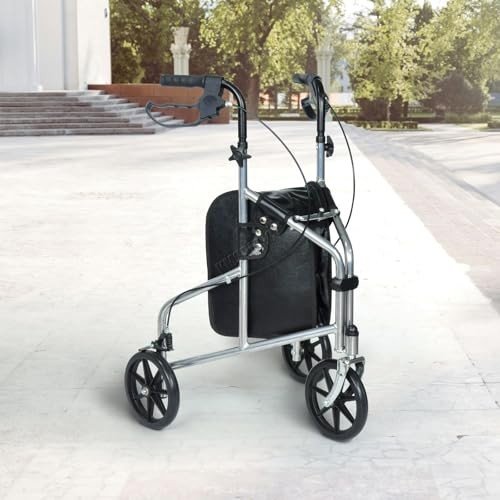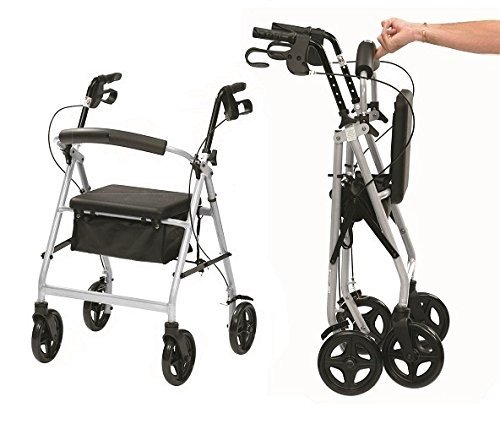lightweight-walker4442
lightweight-walker4442
Guide To Rollator With Brakes: The Intermediate Guide Towards Rollator With Brakes
Understanding Rollators with Brakes: A Comprehensive Guide
As individuals age or experience mobility difficulties, daily tasks can become progressively challenging. A rollator with brakes is a mobility aid created to improve independence and safety for users. These tools not only offer assistance while walking but also come equipped with brakes that make sure stability and control. This post looks into the features, benefits, and factors to consider for choosing a rollator with brakes, along with often asked questions to help potential users make informed decisions.

What is a Rollator?
A rollator is a mobility aid that usually includes a wheeled frame with handgrips, a seat, and, most significantly, brakes. Developed for individuals who need some assistance while walking, rollators provide stability, assistance, and a practical method to rest when required.
Secret Features of Rollators
- Wheels: Most rollators have 4 wheels, which enable smoother movement over numerous terrains.
- Brakes: Handles linked to brakes enable users to manage speed and stop safely when needed.
- Seat: An integrated seat uses an alternative for users to rest when tired out.
- Storage: Many models include baskets or pouches for bring individual products.
Benefits of Using a Rollator with Brakes
Using a rollator with brakes presents various advantages, consisting of:
- Enhanced Safety: The brakes supply stability, preventing falls.
- Self-reliance: Users can move about without help, promoting autonomy.
- Convenience: Built-in storage permits individuals to bring their belongings quickly.
- Versatility: Suitable for both indoor and outdoor use.
Kinds of Rollators with Brakes
Rollators can be found in numerous designs to accommodate different user requirements. The following prevail types of rollators with brakes:
- Standard Rollators: Equipped with four wheels, these appropriate for the majority of users who require standard assistance.
- Heavy-Duty Rollators: Designed for bigger individuals, these rollators come with strengthened frames to offer trusted assistance.
- Compact Rollators: Lightweight and foldable, compact rollators are ideal for travel.
- Three-Wheel Rollators: A flexible choice for maneuvering tight areas, three-wheel models use ease of movement.
| Type of Rollator | Secret Features | Best Suited For |
|---|---|---|
| Requirement Rollator | 4 wheels, fundamental functionality | General users |
| Heavy-Duty Rollator | Reinforced frame, durable materials | Bigger individuals |
| Compact Rollator | Lightweight, foldable style | Travel and mobility |
| Three-Wheel Rollator | Smaller turning radius, easy mobility | Minimal areas |
Elements to Consider When Choosing a Rollator with Brakes
Selecting the right rollator requires consideration of several aspects. Here are important aspects to remember:
- Weight Capacity: Verify the rollator’s weight limit to guarantee it is safe for the user.
- Handle Height: Adjustable handles permit for personalization to match individual height needs.
- Wheel Size: Larger wheels perform better on irregular surfaces, while smaller sized wheels supply agility in tight spaces.
- Folding Ability: If travel is a factor to consider, search for a model that is simple to fold and store.
- Braking Mechanism: Different designs might include different braking systems (e.g., push-to-lock, pull-to-release). Select one that lines up with user comfort.
Upkeep Tips for Rollators with Brakes
Appropriate upkeep ensures longevity and optimum efficiency. Follow these guidelines to keep a rollator in exceptional condition:

- Regular Cleaning: Wipe down the frame and look for collected dirt and particles.
- Check Wheels: Ensure wheels are devoid of obstruction and are properly pumped up if pneumatic.
- Test Brakes: Regularly check if brakes engage and disengage smoothly.
- Change Handles: Make periodic changes to make sure the deal with height remains suitable for the user.
Regularly Asked Questions (FAQs)
Q1: Are rollators ideal for outdoor use?A1: Yes
, many rollators are created for both indoor and outdoor use. Those with bigger wheels tend to carry out better on unequal surface areas.
Q2: Can rollators fold up for easy storage?A2: Most rollators feature a folding feature, making them simple to store and transport. Q3: How do I know if a rollator is
safe for me?A3: Ensure the weight capability meets your needs,
and adjust the handle height for proper ergonomics. Consulting a doctor for suggestions is likewise advisable. Q4: Can I use a rollator with brakes on stairs?A4: Rollators are not developed
for use on stairs. For stair navigation,
individuals must look for other methods of assistance, like hand rails or stair lifts. Q5: How do I care for a rollator with brakes?A5: Regular cleansing, examining for wear and tear, and checking the braking system are crucial steps for maintenance. Rollators with brakes represent an important mobility aid for people looking for enhanced independence and safety. As users evaluate their options
, understanding the different types, features, and upkeep requirements will guarantee they pick the very best rollator for their requirements. With appropriate care and usage, a rollator can substantially boost one’s mobility, contributing to much better lifestyle and higher flexibility in everyday activities.

